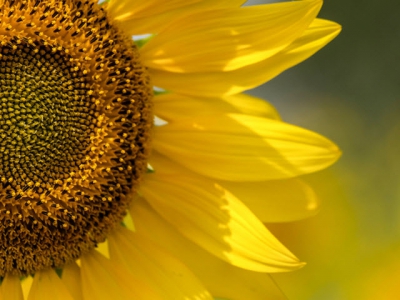8 Plants for Hair and Skin Care

Close-up of a sunflower (Helianthus annuus). Many plants are rich in both vitamins and fatty acids that target everyday hair and skin issues.K-Smile love on Shutterstock
As far back as ancient times, plants have been harvested for their hair and skin benefits. Many are rich in both vitamins and fatty acids that target everyday issues. But just because the plants work magic doesn’t mean they need to be shrouded in mystery. Get to know the ones that can help you look and feel your best.
Sunflower
The Vitamin E and fatty acids in sunflower seed oil work together to target a wide range of skin conditions they’re good protectants against wrinkles and harsh sun rays and have anti-inflammatory properties that fight acne and rashes. Likewise, when applied to the scalp, sunflower seed oil can combat common irritations, like dryness and brittle hair. Look for buzzwords like “high-oleic” and “cold-pressed” on skincare labels. They indicate purer and therefore more potent formulas.
Camelina

By piksel_foto on Shutterstock
Mixed into serums and cleansers, camelina oil functions as an intense emollient. It’s packed with the same omega-3s as salmon, which is one of the only fatty acids your body is incapable of producing on its own. Eczema and psoriasis sufferers have long used camelina oil to moisturize, and recently, it’s become an en vogue ingredient in anti-aging products.
Mint

By sutham on Shutterstock
If you’ve ever bought anything with salicylic acid usually found in topical, spot-treatments you’re familiar with mint’s acne-fighting powers. Here’s the science lesson: Mint is especially astringent, meaning it’s powerful enough to make your skin’s pores contract and squeeze out extra oil.
Bay Leaf

By Roxana Bashyrova on Shutterstock
You can do a lot more with bay leaves than toss a few into a stock pot for flavoring. Ayurveda, an Eastern medicine practice with roots in India, calls on the antioxidant-rich leaves to treat common hair and skin qualms. A bay leaf rinse think a potent tea can help lift dandruff from the scalp while also strengthening hair follicles for future regrowth. If applied to the skin, the rinse targets impurities, which is helpful in treating acne, and can also de-puff without drying out, which makes it a great toner.
Aloe Vera

By Ong.thanaong on Shutterstock
Aloe vera has dominated the beauty aisle for decades. The clear gel found in the leaves of the succulent is famous for treating wounds, bites, and burns. Researchers credit those healing powers to the plant’s ability to speed up skin regeneration. But beyond that, it’s a favorite in anti-aging formulas, too, because it contains Vitamins A, C, and E. All three keep skin firm and moisturized, musts in preventing fine lines.
Burdock Root

By Brent Hofacker on Shutterstock
Because burdock has major clout in numerous cultures, it’s known by a number of names: arctium, thorny burr, cockle buttons. The oil derived from the root works wonders on hair no matter what you call it. It nourishes the scalp with fatty acids and enhances blood circulation, in turn promoting hair growth.
Rose

By Hirundo on Shutterstock
When it comes to the benefits of rose oil, remember the three As: antibacterial, anti-inflammatory, and antioxidants. The first one makes it a good ingredient in face washes, as it works to cleanse skin and fight acne. And while most people associate roses with a deep crimson color, the flowers’ anti-inflammatory properties mean they make your skin look the opposite; rose oil can soothe redness and reduce rosacea. The antioxidants, namely Vitamin C, target future damage from the sun and other free radicals.
Witch Hazel

By billysfam on Shutterstock
Think of witch hazel extract as bottled black magic: It comes from a shrub bearing the same name, and beauty insiders love it for its ability to reduce the appearance of under-eye circles. Since the liquid acts as a mild astringent, it makes the blood vessels beneath your eyes constrict, which reduces puffiness and discoloration. It’s also prized as a toner and makeup remover.
Related news
 Watermelons get cute
Watermelons get cute I’ve borrowed the information in this week’s column from the New York Times newspaper of 17 August 2010 – I thought you might find it interesting.
 Why Should You Care About Seed Diversity? Here are 7 Reasons
Why Should You Care About Seed Diversity? Here are 7 Reasons The loss was even more severe with other vegetables: cabbage varieties dropped from 544 to 28; lettuces from 497 to 36; and radishes from 463 to 27
 Choosing the right cabbage variety
Choosing the right cabbage variety There are hundreds of cabbage varieties on the world market, each filling a slot for some climatic condition or purpose, and quite a few are sold